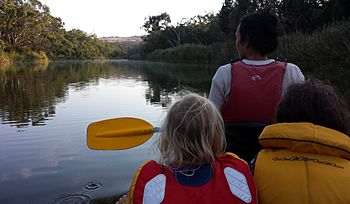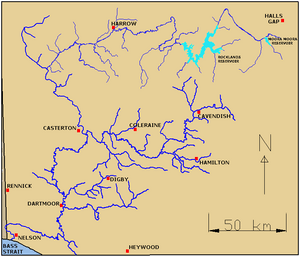Glenelg River (Victoria) facts for kids
Quick facts for kids Glenelg |
|
|---|---|

Family canoeing on the Glenelg River
|
|

Map of Glenelg River catchment
|
|
| Native name | Bochara, Worrewurnin, Bugara, Temiangandgeen, Wurri-wurri, Barrawy, Barker, Wurru-wurru |
| Country | Australia |
| States | Victoria, South Australia |
| Region | Victorian Midlands, Naracoorte Coastal Plain (IBRA), Western Victoria, Limestone Coast, South Australia |
| Local government areas | Southern Grampians (V), West Wimmera (V), Glenelg (V), Grant (SA) |
| Settlements | Balmoral (V), Harrow (V), Casterton (V), Dartmoor (V), Donovans (SA), Nelson (V) |
| Physical characteristics | |
| Main source | Grampian Ranges Grampians National Park, Victoria 759 m (2,490 ft) 37°20′57″S 142°15′57″E / 37.34917°S 142.26583°E |
| River mouth | Discovery Bay, Great Australian Bight Nelson, Victoria 0 m (0 ft) 38°03′39″S 140°59′8″E / 38.06083°S 140.98556°E |
| Length | 350 km (220 mi) |
| Basin features | |
| River system | Glenelg Hopkins catchment |
| Basin size | 12,660 km2 (4,890 sq mi) |
| Tributaries |
|
| National parks | Grampians, Lower Glenelg |
The Glenelg River, a perennial river of the Glenelg Hopkins catchment, is located in the Australian states of Victoria and South Australia.
The river rises in the Grampian Ranges and flows generally north, then west, then south, for over 350 kilometres (220 mi), making the river the longest river in south-west Victoria and third longest overall. A short stretch of the lower end winds through southeastern South Australia before returning to Victoria to enter Discovery Bay at Nelson. The Glenelg River is a central feature of the Lower Glenelg National Park.
The river was named after Colonial Secretary Baron Glenelg, Charles Grant, by Major Thomas Mitchell in August 1836.
Large amounts of water diverted from the upper reaches of the river for agricultural purposes, including irrigation and town water demands. The estuary is listed under the and is a nationally important wetland.
Contents
History
Aboriginal history
The Glenelg was important to Indigenous Australians. It formed the traditional tribal boundaries for the nomadic Bungandidj people (western bank) and Gunditjmara people (eastern bank) people from two distinct language groups. Little archeological evidence has been found of Bunganditj in-habitation along the river itself, including in the regions many caves, there is strong evidence of their presence in nearby coastal areas. While strong evidence of Gunditjmara activity has been found along the river's eastern hinterland and shell middens discovered may indicate multiple nomadic tribes camping along the river that may have used message sticks to communicate. It is not known how long indigenous Australians had been associated with the river, however it is estimated to have been many thousands of years.
European history
Major Thomas Mitchell was the first European to visit and cross the river in August 1836, noting its width and its suitability for boating, naming it for Colonial Secretary Baron Glenelg, Charles Grant. A cenotaph at Nelson marks the crossing point. The first Europeans arrived in 1840. Thomas Ricketts moved from the Barwon River to the Glenelg and established "Clunie" on its southern boundary. Historians noted the hostility of the Indigenous people of the area who drove Ricketts out of the settlement and conflicted with many others. Addison and Murray from Van Diemen's Land set up the sheep run Dunrobin in January, 1840 after which more than half a dozen squatters others followed, and by the end of the year, many properties had river frontages and the population grew gradually thereafter.
A punt built in 1848 by Henry Kellett at Nelson was the first permanent crossing of the river. On 1 July 1861, at Chetwynd station, a large tornado occurred reportedly killing a man. In 1866, one of the earliest artists depictions of the river by engraver Frederick Grosse "View of the River Glenelg, South Australia" was published depicting boating among its steep limestone cliffs. The earliest crossings over the Glenelg were at Casterton. The first crossing over the wider reaches of the lower Glenelg was constructed out of wood in 1893 in Nelson. It was replaced by the current steel cantilever bridge in 1963.
Location and features
The Glenelg River rises at an elevation of 760 metres (2,490 ft) above sea level below The Chimney Pots within the Grampians National Park, on the eastern slopes of the Victoria Range, and west of the Serra Range, within the Grampian Range. The river flows north through swampland before heading west, transversed by the Henty Highway, and then south where the river is impounded by the Rocklands Reservoir, formed by a concrete–walled gravity dam with embankment sections constructed in 1953. The reservoir has a maximum capacity of 348,300 megalitres (7.66×1010 imp gal; 9.20×1010 US gal). Leaving the dam wall, the river flows west through state forestry areas towards Balmoral, where the river is joined by the Salt, Mather, Yarramyljup, and Schofield Creeks, flowing to the east, north, then west of Balmoral, through the settlement of Harrow, where the river is met by another creek, also called Salt Creek. The Chetwynd River, draining the region north of Casterton and Coleraine, joins the Glenelg east of Burke Bridge. The Glenelg flows generally southwest, to the west of Dergholm State Park towards Dergholm, joined by a number of minor tributaries. From here the river flows south by east, through the town of Casterton, and south of which the 220-kilometre (140 mi) Wannon River forms its confluence with the Glenelg. Flowing south by west, the Glenelg flows through the Wilkin Flora and Fauna Reserve before heading due south, met by the Stokes River prior to flowing through the town of Dartmoor where the Crawford River forms its confluence with the Glenelg. Flowing south, then sharply west and crossing the state border into South Australia, the Glenelg flows through Donovans before heading east back into Victoria. The river reaches its mouth at Nelson and much of the latter course is through the Lower Glenelg National Park. From its highest point, the Glenelg River descends 760 metres (2,490 ft), joined by thirty–two named tributaries over its 350-kilometre (220 mi) course.
Communities and significant crossings along the river
There are many crossings over the Glenelg River, including road, rail and pedestrian. Some additional roads allow passage through shallow sections of the river when the water levels are low.
| Location | Bridge name | Comments/use | Image |
|---|---|---|---|
| Kanagulk | Natimuk Hamilton Road | ||
| Harrow | Coleraine-Edenhope Road | ||
| Connewirricoo | Kandnock-Connewirricoo Road | ||
| Kadnook | Casterton-Edenhope Road | ||
| Dergholm | Dergholm-Chetwynd Road | ||
| Warrock | Warrock Road | ||
| Dunrobin | Section Road | ||
| Casterton | Glenelg Highway |  |
|
| Anderson Street | |||
| Sandford | Sandford-Ballgalah Road | ||
| Bahgallah | Casterton-Dartmoor Road | ||
| Strathdownie | Myaring-Pieracle Road | ||
| Dartmoor | Greenham Street | ||
| Railway crossing | |||
| Princes Highway | |||
| Nelson | Portland-Nelson Road; 1893 wooden; 1963 steel cantilever |
Flora and fauna
The Glenelg River mussel, once plentiful but now critically endangered, lives in small populations along the river. Work is being done to improve its habitat, after it was further threatened by the bushfires in 2019-2020.

